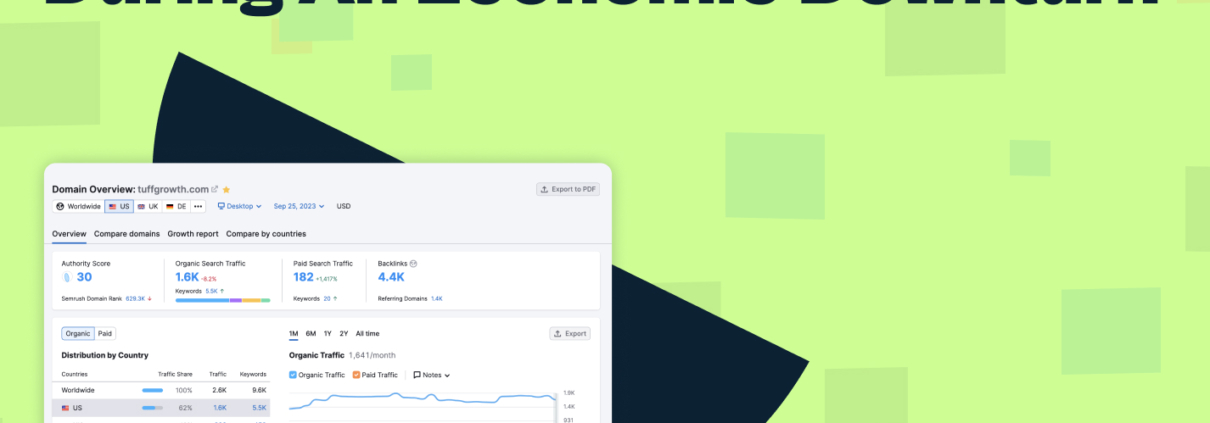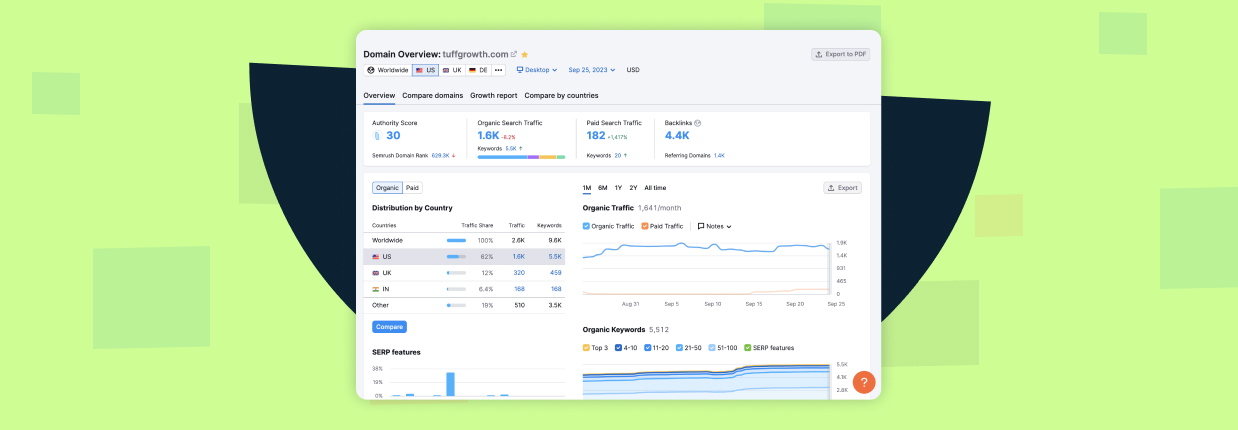Prioritizing Unpaid Channels During an Economic Downturn
As we watch companies scale back both their workforce and spend, it becomes clear (again) that unpaid channels are vital to a healthy marketing and sales strategy. Businesses are trying to be cognizant of spending without canceling all long-term investments, so in terms of priority, unpaid channels have moved to the top of the growth list.
If you haven’t invested in organic channels or if you’ve taken a hiatus from that investment, it’s time to get back in the game. Unpaid channels are a sustainable and helpful fallback during economic downturns.
Organic is a long-term play. Strategies within SEO, for instance, take time to build up and take frequent maintenance. So the longer you neglect your organic visibility, the longer it will take to catch up to your competitors. Prioritizing a solid foundation now means that you start reaping the benefits sooner.
Aside from SEO, there are endless unpaid opportunities you can leverage while pinching pennies. From branding to experimentation all the way to that website refresh you’ve been holding off for far too long.
Let’s walk through a step-by-step guide on how companies should be spending their time and marketing budgets in 2023.
Step 1: Self-care, but make it branding
At Tuff, we see a lot of well-established companies come through without having performed any brand or audience exercises to establish voice, tone, and persona targeting strategies for their website and campaigns. Putting in the work here is important both on and off your site. A strong, established brand is the secret sauce to campaign success and customer loyalty.
When you’re looking to save money but spend your time productively, it’s a great time to tighten up brand messaging, produce value-driven content, and build relationships with new and existing customers.
Here’s a branding checklist you can use to get started:
- Establish your brand’s mission and purpose
- Understand your competitors (how do you stand out)
- Determine your target audience and create personas
- Shape your brand’s voice and tone
- Modify how your organization discusses your products or services
- Ensure all digital property emulates your brand identity
Once you’ve made these branding decisions, it’s important to audit your website and ensure it represents your brand well. The areas that will get you the most bang for your branding buck are updating high-intent pages and creating a fresh content strategy that’s brand mindful while delivering the information your audience needs.
Step 2: Content with a twist
“People still crave information and solutions to their unique challenges, especially during a downturn.Tap into the emotions and needs of your audience, now and into the future. Create evergreen content that connects and builds trust in your brand. You’ll reap long-term returns from your content and keep your base engaged while others pull back.” – Bridget Doherty, UX Copywriter
Content will always be an important part of your branding and marketing strategy. It’s also the easiest to upkeep while cutting budgets.
Take advantage of this time and create a solid plan for content production and promotion. Leverage your internal experts to write pieces that grab and hold your audience.
When we think of content marketing, we usually think of fresh content to bring in new customers. However, content is a valuable way to stay connected to existing customers and provides a direct line of communication for brand loyalty and upsells.
The probability of selling to an existing customer is between 60% and 70% while that number is only between 5% to 20% for new customers, so give your current customers plenty of attention during this time and beyond.
Step 3: Designing your strategy
High-quality design has become an expectation of customers. In today’s digital world, well-designed websites, social feeds, emails, videos, and blogs is the norm. Meaning, your customers hold you to a higher standard than you think.
When potential customers come to your site, they’re bringing the experiences they’ve had on every other site (especially those of your competitors). They’re always looking for speed, ease of use, and, whether they realize it or not, something that’s easy on the eyes.
Investing in design can help to:
- Ensure that your product or service is easy to use and understand
- Connect with customers on an emotional level
- Make your brand stand out and your company more memorable
- Build a positive brand image
- Gain customer trust and loyalty
If you don’t have a resource internally now, it’s a worthwhile investment to bring on a partner who can support your brand’s design needs.Generally speaking, it’s often cheaper to outsource design work to an agency, as they have lower rates and can provide a wider range of services. Hiring a full-time designer can be more expensive when you’re trying to save, as it involves additional costs such as benefits and other overhead expenses.
Don’t let your campaigns be wasted on lack of design and branding.
Step 4a: Your Website & SEO
Think of your website like it’s your home. A strong foundation is important and when something breaks, it’s best to take your time and fix it correctly. Shortcuts risk the problem becoming out of control.
Enter SEO.
“When consumers begin spending at normal levels again, companies that have pulled back on SEO efforts will have to make up for lost performance. Companies that keep SEO rolling won’t have to backtrack and deal with drops in visibility and lost rankings as other companies overtook them on the SERP.”- Claire Routh, SEO Strategist
SEO is a secret weapon that’s important to keep in your arsenal, whether it’s keeping up with content optimization and creation to sustain organic visibility or monthly maintenance on your website to ensure it provides a good user experience..
Poor site performance and lack of keyword support can be detrimental to your visibility in search. Sites that give users a bad experience are penalized for this and the same goes for poor keyword targeting. Not using the right language to find the right audience can mean useless traffic and irrelevance within search engines.
As you face uncertainty during financial hardship, shift your strategy to long-term, unpaid investments. Take the time to finesse on-site content to target keywords that will bring in high-intent audiences. Focus on maintaining a healthy site experience for your users so they’re more willing to come back again as they continue on the buyer journey.
Start now and keep up with it even once you’re back at full force with your paid investments. A consistent organic strategy is an ironclad way to guard against tumultuous times.
Step 4b: Your Website & Experimentation
So, you finally figured out your branding, content, design, and you’re maintaining SEO support on your site… Now what?
Even though you’ve refined your brand’s online presence, the best way to see what truly resonates with and converts your audience is to start testing. From headlines to CTAs, websites present endless testing opportunities. This is the perfect way to improve conversion rates and sustainably grow the leads flowing through your pipeline without having to toy with money in paid platforms.
Forming the habit of testing before solidifying decisions about your brand ensures you’ll always have a pulse on the market and the needs of your customers.
It’s surprising how often we see clients making major site changes because they like it internally. Just because we like something doesn’t mean it will actually be successful at speaking to customers. When in doubt, test it out. It’s not just the experience your customers need, it’s the one they deserve.
Step 5: Organic social and partnerships
With paid social as successful as it is for a lot of companies, the upkeep of social media platforms organically is often forgotten. Staying active and organically engaged on social media is a great way to keep visibility with your audience and keep customers engaging with your brand.
The same is true for partnerships. During a downturn when budgets are cut, focusing your energy toward building and strengthening partnerships is time well-invested. The exchanging of content or more logo visibility off-site is the perfect, low-budget strategy to get eyes from untapped audiences.
Don’t you… forget about paid
During an economic downturn, it can be easy to make a rash decision like completely cutting budget to certain channels but it can actually be a great time to get strategic with your ad spend.
Nielsen Marketing Mix Models found that when companies go cold turkey and cut channels out of their media mix, they can expect to lose 2% of their long-term revenue each quarter and found that it will take up to 3-5 years to recover.
Nielsen data also shows that marketing accounts for 10%-35% of a brand’s equity, proving if budget cuts are done incorrectly, it can have major impacts across your organization.
You’ll find your competitors will also be dealing with budget cuts, meaning campaigns that were once highly competitive in the market can now be high-opportunity. Campaigns that historically haven’t had much return can have a greater impact now.
The solution isn’t making hard budget cuts but rather allocating your budget towards the channels or campaigns that will have the most return at this time. Knowing how to watch the trends and keep your strategy agile is an important factor to sustaining paid media, and having a partner who brings that expertise can be the best tool for being cautious yet effective with your budget.
It’s all about balance
Ultimately, whether you’re just getting started with unpaid investments or picking things back up, create a sustainable plan to upkeep your organic channels even as you ramp back up with paid media.
Whether it’s leveraging high-value content on and off the site or sharing keyword and audience insights to support and improve campaigns, there are endless opportunities for cross-collaboration. Add CRO into the mix by testing everything from ad copy to elements on your landing pages, and have a media mix that’s a recipe for digital success.
It seems more complicated than it is, though we are the experts. Reach out if you need an assist ramping up and maintaining your organic efforts.






